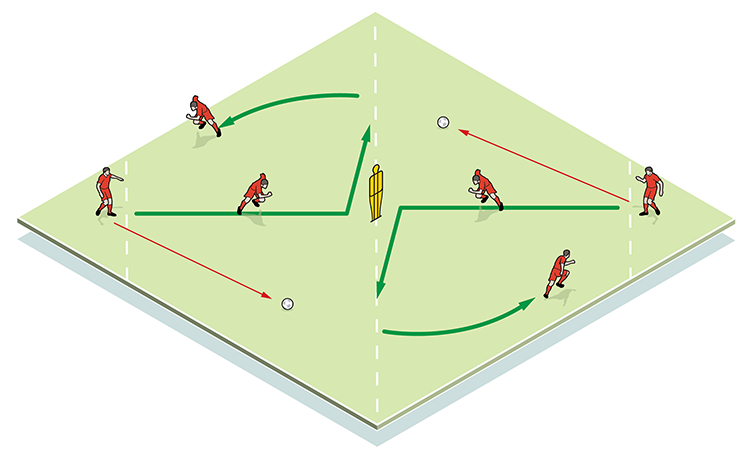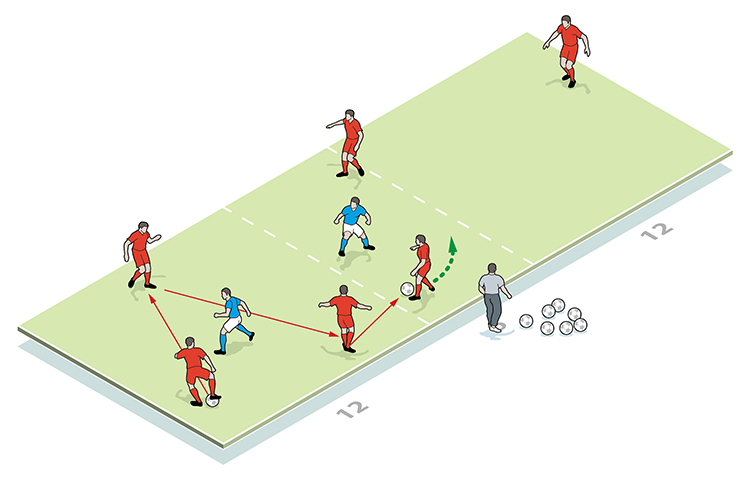Help your players master basic elements such as movement and rotation in receiving the ball. It’s really important to practise these elements because they represent core skills, and influence almost every match day scenario.

| Area | Up to 85x70 yards |
| Equipment | Balls, cones, goals, mannequins |
| No. of Players | Up to 16 |
| Session Time | Technical practice 10mins, Opposed practice 10mins, Small-sided game 20mins |
This session begins as a technical practice, moves to an opposed practice before being developed into a small-sided game.
As a coach, I’m always looking for players to master basic elements such as movement and rotation in receiving the ball, and with that, the decision process behind the onward pass. However simple they are, it’s really important to practise these elements because they represent core skills, and influence almost every match day scenario.
The session is one that should be repeated regularly so players learn and understand the expectations of not only their coach, but team mates as well.
What do I get the players to do?
Technical practice
Set up as shown in the diagram. For the technical practice, we are looking for the two central players to move out to the ball, control, turn, and pass it on. The technique is designed to produce a good first touch that sees them ‘breaking (imaginary vertical) lines’ whilst shielding the ball and preparing to move it on (1a).
1a

Having two men on left and right stations mean players can rotate around the area after each pass and into new positions, so the move retains its flow and momentum (1b).
1b

Opposed practice
Setting up as shown (2a), this is a two-way practice. Attackers must maintain possession and, using their overloads, transfer the ball from one end to the other. Each attacker in each area must touch the ball before it’s moved on and we’re looking for various movement and rotation patterns, plus precise timing (2b).
2a

2b

When the ball completes its route into the end zone, two attackers from the central zone move forward to support the receiver. Two attackers from the deeper third then enter the middle zone.
The defender in the middle zone moves into the top zone and presses against three attackers. The defender from the first zone goes into the middle zone allowing the practice to now come back the other way. Rotate defenders every minute.
Small-sided game
In the 8v8 small-sided game, attackers must always play through a man in the middle zone in order to move up the pitch (3a). The game combines both previously rehearsed ideas – breaking and passing through the lines. The ability for players to be able to do this depends on the quality of rotation and movement, plus the timing of support play in the middle zone (3b).
3a

3b

What are the key things to look out for?
In each practice, movement, rotation and support are the key elements.
Editor's Picks
Attacking transitions
Deep runs in the final third
Using the goalkeeper in build-up play
Intensive boxes drill with goals
Penetrating the final third
Creating and finishing
My philosophy
Pressing initiation
Compact team movement
Coaches' Testimonials
Coaches' Testimonials
Join the world's leading coaches and managers and discover for yourself one of the best kept secrets in coaching. No other training tool on the planet is written or read by the calibre of names you’ll find in Elite Soccer.
In a recent survey 92% of subscribers said Elite Soccer makes them more confident, 89% said it makes them a more effective coach and 91% said it makes them more inspired.
Get Monthly Inspiration
All the latest techniques and approaches
Since 2010 Elite Soccer has given subscribers exclusive insight into the training ground practices of the world’s best coaches. Published in partnership with the League Managers Association we have unparalleled access to the leading lights in the English leagues, as well as a host of international managers.
Elite Soccer exclusively features sessions written by the coaches themselves. There are no observed sessions and no sessions “in the style of”, just first-hand advice delivered direct to you from the coach.























